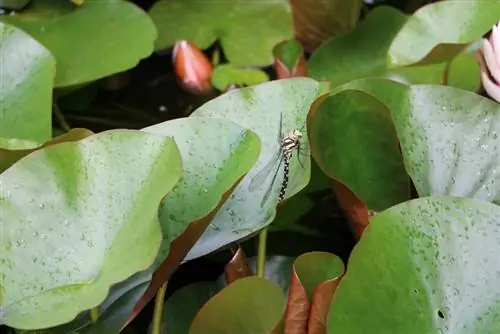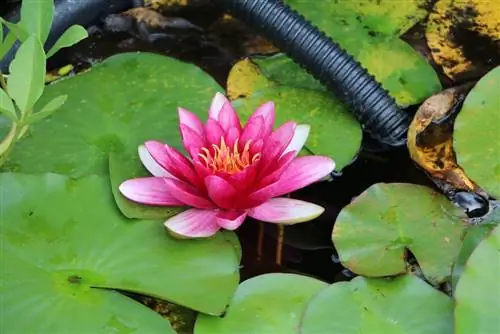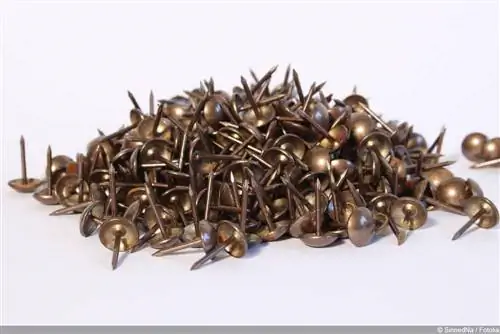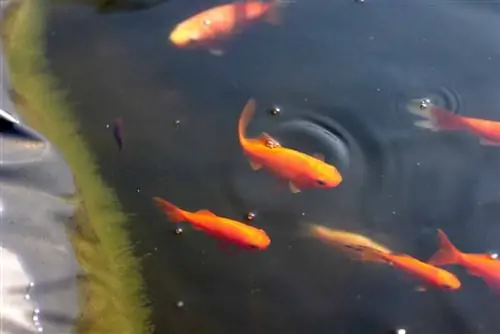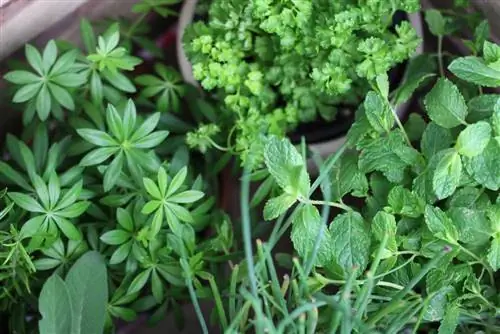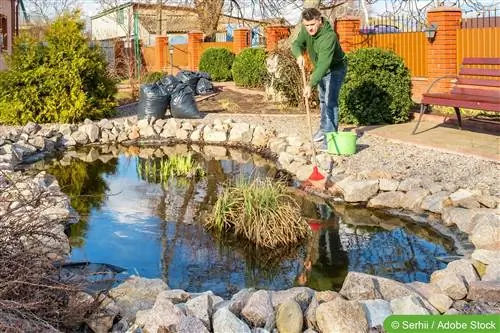- Author admin [email protected].
- Public 2024-01-15 11:54.
- Last modified 2025-06-01 06:48.
The most commonly used pond trays have two to three different depth zones for planting and have curved edges. You want them to look as natural as possible, but that's really not easy to do. Somehow you can always recognize the artificial shape, although the edges can be beautifully designed. With a little imagination and good advice from an expert, an artificial pond like this can look good.
Plan a pond tub
Installing a pond tray is not particularly complicated. Small tubs are actually quite easy to install. With large ones, the work required is significantly higher, of course, more earth has to be dug out.
Tip:
What you should definitely consider before building a pond in your garden is that it must be inaccessible to children. This doesn't just mean your own children, but especially their friends, neighbors' children, visitors and the like. Water has a great attraction for children and they often underestimate this. Every year there are numerous accidents caused by unprotected garden ponds and they often end tragically.
Materials for pond tubs
There are different materials for making pond basins. They all have advantages and disadvantages.
PE pool
The cheapest pond tubs are made of PE, i.e. polyethylene. They are pressed using a deep-drawing process. Unfortunately, it has been shown time and again that the thin-walled material is not uniformly strong. The thin areas are particularly noticeable when you hold the tub with the opening facing downwards against the light. These thin places quickly become leaky. PE pond pools are only suitable with a capacity of up to 500 liters, a maximum of up to 1,000 liters.
GRP pool
These cymbals are significantly more durable and of better quality, which is of course also reflected in a higher price. The material is glass fiber reinforced plastic. The tubs are manufactured in a variety of sizes, shapes and colors. They are even used for swimming pools. They are particularly popular as koi ponds. GRP ponds are available with a capacity of up to several 10,000 liters. Almost every wish can be implemented.
Advantages
- Great variety of shapes
- Various sizes
- Different colors
- No annoying wrinkling like with liner ponds
- Better protection against being punctured by roots or stones
- Easy to repair
- Great for small ponds up to large swimming pools
Disadvantages
- Higher price
- Large pools are cumbersome and more difficult to install
Preparations for installation
For small ponds, a shovel and spade are sufficient to dig the pit. For large pond tubs, however, it is recommended to rent a small excavator. This makes the work easier and quicker and it's also fun once you get the hang of it. Sand is also needed as a base and for fitting the sides and water for slurrying. A spirit level and a rubber mallet are also important.
If you want clear water in your pond, you usually can't avoid a pump and filter. They are particularly important when stocking fish. Electricity is required for technology, including lights, fountains, gargoyles and the like. Water and electricity connections are convenient nearby. The actual installation of the pond tray is not difficult at all, especially if the project has been well planned. Preparation is important. This includes selecting the appropriate pond bowl, the appropriate location and marking out the construction project.
Pond bowls are available in such a large selection that you can quickly lose track. The pools differ in size, shape, material, color, depth, planting zones and of course in price. Supposed super bargains should be viewed with caution; the prices are often so cheap for a reason. Material defects are not uncommon and no one enjoys a leaking pond.
If you are planning a pond in the middle of the garden, it is best to use a rounded pond tray that is intended to simulate a naturally created pond. If, on the other hand, you are planning several pools, regardless of whether they are arranged in a row, offset or to border the terrace, it is better to use straight pond trays, rectangular or square.
The location is important for the natural balance in the pond. It should be sunny, but not too sunny. Especially in small ponds, make sure that the water surface is not exposed to sunlight all day long. The water heats up too much, and an algae plague is usually the result. Shading during midday makes sense. Even in large ponds, shading individual areas is beneficial.
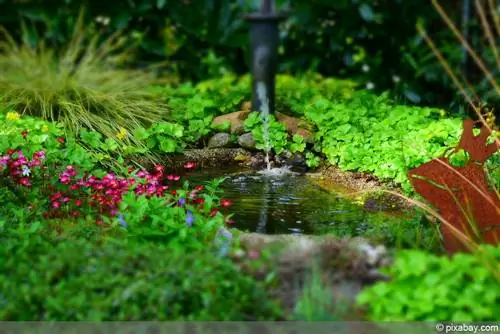
Tip:
Too much sun is unfavorable, then it is better to have a lot of shade, even if not from a deciduous tree (leaf infestation). Although shade is not ideal because not all plants can tolerate it, it is less harmful than pure sun. If you don't mind the algae caused by the sun, you can also create the pond in a completely sunny place.
Install pond tub
Mark outlines
No matter what shape of pond you have chosen, the floor plans are drawn on the garden floor first. Sand, sawdust, sawdust or even a long string are suitable for “drawing”. The easiest way is to place the pond tray upside down on the ground and then mark around the outside. The pit is then dug.
Dig a pit
Digging the pit for small ponds is done with a shovel and spade, for larger ponds it is better to use an excavator. You can borrow it. When excavating, create the individual levels depending on the shape of the pond tray. It is best to place the bowl in the pit every now and then and check the fit. You should keep in mind that there will still be a layer of sand at the bottom of the pit. These 5 to 10 cm must be dug deeper.
Adjust pond bowl
The pond bowl must be aligned accordingly. It is best if one or more people (if the size is appropriate) climb into the bowl so that it is properly pressed into the pit. This also makes it easy to determine where the excavation doesn't really fit. More has to be dug out there, or the other way around, earth has to be filled in again. The shell must be inserted again and again to check its fit. It must not wobble around and must lie straight.
Removing roots and stones
Once the optimal fit has been found, all roots and stones must be removed from the pit, as they can damage the pond tray.
Apply a layer of sand
Spread a 5 to 10 cm thick layer of sand on the bottom of the pit. It serves to protect the pond tray and to equalize voltage. The shell does not tolerate stress well and in the long run this leads to fine cracks. The edge of the pond must be level with the surrounding area. There must be no voids on the floor.
Let in some water
Water can now be let in. The best solution is rainwater, which of course has to be collected beforehand. This is easy for small ponds, but more complicated for large ponds. At the beginning only 1/3 water comes into the pond. The weight of the water aligns the bowl again. Use the spirit level to check whether the edges are straight. Most spirit levels are too short. A straight roof batten or, better yet, an aluminum batten that is placed over the edges is useful here.
Fit the tub exactly
The pond tray must now be brought into its final position by shaking and turning. It's a good idea to leave everything for a day or two because a lot of things can still move.
Slurrying and filling
If the pond is properly aligned, the voids around it must be eliminated. To do this, water is let in all around using the water hose. The earth slides and the cavities become visible. Sand belongs in there. This is repeatedly refilled with water until it no longer slips.
Create border
If you want to put the previously cut sod back in at the end, you have to leave a few centimeters free at the top so that the height at the end is right with the grass. Most pond builders put a layer of gravel or river pebbles around the pond, just to hide the edge.
Tip:
It's better than having everything on one level if the pond is slightly higher than its surroundings. This prevents rain from washing soil, fertilizer or subsoil into the pond.
Installing technology
If you want to install technology in your pond, do so now. In a pond tub, the hoses and cables are usually routed from above along the edge of the pond to the bottom. However, larger pond tubs have connection points in the floor. This has the advantage that you cannot see the cables.
Planting a pond
It is easier to plant the pond if it is not yet full. Only after planting let water in up to the edge.
Plant pond tub
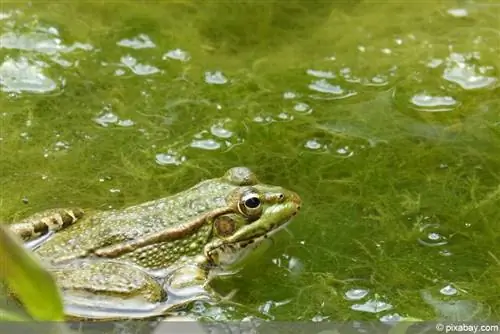
When planting, please note that not every aquatic plant is suitable for these pond tubs. The plants must be placed in the individual zones according to their requirements. It is important not to use too many species and varieties, as this creates quite a mess. You also need to pay attention to the vigor of the plants. Strong-growing varieties soon overgrow everything and you can no longer see any water. It's best not to use so many plants, because some will settle on their own.
Underwater plants
Water crowfoot - Water depth 30 to 80 cm, blooms June to September, white flowers, can form one meter long shoots, only for larger water areas, stems float on the water, like moving water, copes well with calcareous water, needs to be thinned out every now and then
Floating plants
- Shell flower - grows 5 to 10 cm high, flowers very rarely, 30 to 50 cm water depth, lettuce-leaved leaf rosettes, roots hang in the water, only put in the water at the end of May, like lots of sun, warm water, runners can be separated
- Swimming Fern - grows to a height of 10 to 15 cm, does not flower, for 20 to 50 cm deep water, regularly oval leaflets on short, barely branched shoots, can be planted from April and May, like nutrient-rich water, strong growth, always fish a few leaves out of the water so that the water surface does not grow over
Water Lilies
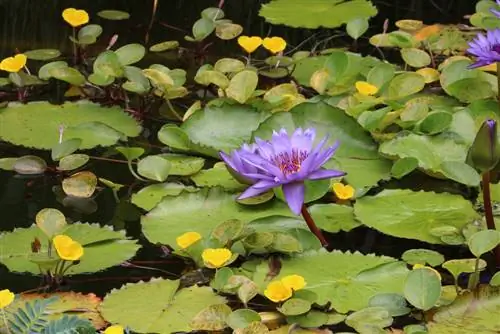
- Dwarf water lily (Nymphaea candida) - flower diameter 8 to 10 cm, flowering from June to August, water depth 25 to 50 cm (up to 80 cm), dark green round leaves (diameter 20 cm), white flowers, can be planted from May, press fertilizer kneaded in clay balls into the soil of the baskets in spring, hardy, quite easy to grow
- Water lily (Nymphaea x pygmaea 'Helvola') - small yellow flowers, only 2.5 cm in diameter, bloom from June to September, water depth 20 to 25 cm, not hardy, leaves dark green, can have red to reddish-brown stripes or spots, fertilize in spring (as just described) ideal for containers, great with blue-flowering perennials on the edge
- Water lily (Nymphaea x laydekeri (varieties) - flowers pink (light purple pink inside darker or strong dark red with white markings, depending on the variety), up to 10 cm in diameter, Flowers June to September, water depth 25 to 30 cm, plants from mid-May, slow-growing, fertilize as described above, very willing to flower, ideal for pots
- Square water lily (Nymphaea tetragona) - small flowers, only 2.5 cm in diameter, pure white and fragrant, blooms from June to September, water depth 10 to 25 cm, can be planted Mid-May, the most delicate water lily, even grows in shallow bowls, then do not overwinter outdoors (commonly sold in stores under the name: Nymphaea x pygmaea 'Alba')
Shallow water plants
- Swamp calla - 15 to 20 cm high and just as wide, white flowers, between June and July, up to 20 cm deep, leaves sprout directly from the creeping rhizome, berries in autumn (poisonous), plant from the end of April, without a planter, simply place the rhizome on the substrate and weigh it down with a flat stone, it often dies in winter
- Water feather - grows like a lawn, is 20 to 40 cm high, winter green, flowers white to soft pink from June to July, water depth up to 40 cm, shoot and leaves under water, flowers on bare stems above water, plant from the end of April, tolerates some shade, absolutely soft water, acidic substrate if possible, can be cut back in spring
- Fir fronds - upright shoots with needle-shaped leaves in shallow water, 20 to 40 cm high and wide, inconspicuous flowers from June to August, water depth 10 to 30 cm, plant from the end of April, heavily overgrown runners, so be sure to put them in a plant basket, cut runners off regularly, ideal for hiding technology or bricks
- Water iris - green-yellow striped leaves, up to 80 cm high, yellow flowers from May to July, planting depth 5 to 15 cm, needs sun and nutrient-rich water, beautiful touches of color
Conclusion
Pond tubs have their advantages and disadvantages. If you want the pond to appear very natural in the end, they are less suitable because it is difficult to hide the fact that they are artificial pools. The edges remain visible and appear fake. However, they are ideal as formal pools. The edges can be easily covered because they are straight and there are proper 90° corners. Wooden slats are suitable as materials, but stainless steel and aluminum are even better. With cladding you can't see the edge and the effect is completely different. The pond tubs are even suitable for installation in or around terraces.

